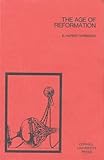The Age of Reformation / E. Harris Harbison.
Material type: TextSeries: The Development of Western CivilizationPublisher: Ithaca, NY : Cornell University Press, [2013]Copyright date: ©2013Description: 1 online resource (160 p.)Content type:
TextSeries: The Development of Western CivilizationPublisher: Ithaca, NY : Cornell University Press, [2013]Copyright date: ©2013Description: 1 online resource (160 p.)Content type: - 9780801468544
- 270.6
- BR305
- online - DeGruyter
| Item type | Current library | Call number | URL | Status | Notes | Barcode | |
|---|---|---|---|---|---|---|---|
 eBook
eBook
|
Biblioteca "Angelicum" Pont. Univ. S.Tommaso d'Aquino Nuvola online | online - DeGruyter (Browse shelf(Opens below)) | Online access | Not for loan (Accesso limitato) | Accesso per gli utenti autorizzati / Access for authorized users | (dgr)9780801468544 |
Frontmatter -- Foreword -- Contents -- Introduction -- I. The European World about 1500 -- II. The Religious Upheaval -- III. The Struggle for Power -- Chronological Summary -- Suggestions for Further Reading -- Index
restricted access online access with authorization star
http://purl.org/coar/access_right/c_16ec
In The Age of Reformation, first published in 1955, E. Harris Harbison shows why sixteenth-century Europe was ripe for a catharsis. New political and social factors were at work—the growth of the middle classes, the monetary inflation resulting from an influx of gold from the New World, the invention of printing, the trend toward centralization of political power. Against these developments, Harbison places the church, nearly bankrupt because of the expense of defending the papal states, supporting an elaborate administrative organization and luxurious court, and financing the crusades. The Reformation, as he shows, was the result of "a long, slow shifting of social conditions and human values to which the church was not responding readily enough. The sheer inertia of an enormous and complex organization, the drag of powerful vested interests, the helplessness of individuals with intelligent schemes of reform—this is what strikes the historian in studying the church of the later Middle Ages."Martin Luther, a devout and forceful monk, sought only to cleanse the church of its abuses and return to the spiritual guidance of the Scriptures. But, as it turned out, western Christendom split into two camps—a division as stirring, as fearful, as portentous to the sixteenth-century world as any in Europe’s history. Offering an engaging and accessible introductory history of the Reformation, Harbison focuses on the age’s key individuals, institutions, and ideas while at the same time addressing the slower, less obvious tides of social and political change. A classic and long out-of-print synthesis of earlier generations of historical scholarship on the Reformation told with clarity and drama, this book concisely traces the outlines, interlocked and interwoven as they were, of the various phases that comprised the "Age of Reformation."
Mode of access: Internet via World Wide Web.
In English.
Description based on online resource; title from PDF title page (publisher's Web site, viewed 26. Apr 2024)


